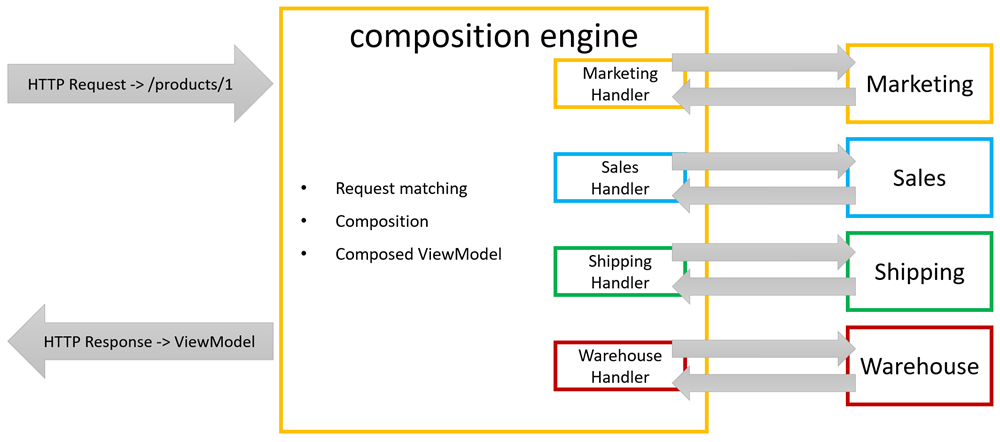
The ViewModels Lists Composition Dance
We recently looked at some pseudo code showing how Single Item Composition could work. At the end of that article the composition flow was summarized as:

The diagram is a bird-eye view of the composition flow, and misses details about list composition whose darkness we’ve already investigated. But now it’s time to see how it looks in code.
Looking for a ViewModel Composition framework? Take a look at the open source ServiceComposer.AspNetCore.
Let’s dance
In the above articles, Marketing is identified as the one owning the Product concept, and as such is responsible to return the list of Products:
class MarketingProductsListGetHandler : IHandleRequests
{
public bool Matches(RouteData routeData, string httpVerb, HttpRequest request)
{
var controller = (string)routeData.Values["controller"];
var action = (string)routeData.Values["action"];
return HttpMethods.IsGet(httpVerb)
&& controller.ToLowerInvariant() == "products"
&& action.ToLowerInvariant() == "index"
&& !routeData.Values.ContainsKey("id");
}
}
First things first. The MarketingProductsListGetHandler is interested in all requests that are for the products controller and don’t contain an id. In essence URLs like /products.
class MarketingProductsListGetHandler : IHandleRequests
{
public bool Matches(RouteData routeData, string httpVerb, HttpRequest request)
{
/* omitted for clarity */
}
public async Task Handle(dynamic vm, RouteData routeData, HttpRequest request)
{
var url = $"http://marketing.backend.local/api/available/products";
var response = await new HttpClient().GetAsync(url);
var availableProducts = await response.Content.As<int[]>();
}
}
Whenever a matching request is intercepted, Marketing retrieves the list of available products and returns only their IDs.
Marketing also owns names and descriptions, so in a real-world scenario they would have been returned in the same response.
At this point all the other actors that want to take part in the composition process need to be notified:
public class AvailableProductsLoaded
{
public IDictionary<int, dynamic> AvailableProductsViewModel { get; set; }
}
Marketing, being the owner, defines the above AvailableProductsLoaded event, and raises it:
class MarketingProductsListGetHandler : IHandleRequests
{
/* Matches omitted for clarity */
public async Task Handle(dynamic vm, RouteData routeData, HttpRequest request)
{
var url = $"http://marketing.backend.local/api/available/products";
var response = await new HttpClient().GetAsync(url);
var availableProducts = await response.Content.As<int[]>();
var availableProductsViewModel = MapToDictionary(availableProducts);
await vm.RaiseEvent(new AvailableProductsLoaded()
{
AvailableProductsViewModel = availableProductsViewModel
});
vm.AvailableProducts = availableProductsViewModel.Values.ToList();
}
}
The first thing is to prepare a data structure suitable for event handlers that need to augment each Product. Here we can use a Dictionary:
IDictionary<int, dynamic> MapToDictionary(IEnumerable<int> availableProducts)
{
var availableProductsViewModel = new Dictionary<int, dynamic>();
foreach (var id in availableProducts)
{
dynamic vm = new ExpandoObject();
vm.Id = id;
availableProductsViewModel[id] = vm;
}
return availableProductsViewModel;
}
Once that’s ready the AvailableProductsLoaded event is raised, and finally the composed ViewModels are appended to the response ViewModel (vm).
The way the event is raised and dispatched to handlers is still hidden in the composition infrastructure. Don’t despair, there will be a dedicated article.
False notes: events are not requests
The IHandleRequests interface is clearly insufficient. Semantically, it’s not designed to handle events. Instead we’ll use a new interface:
interface ISubscribeToCompositionEvents
{
void Subscribe(ISubscriptionStorage subscriptionStorage, RouteData routeData, HttpRequest request);
}
ISubscribeToCompositionEvents expresses the intent much better. Components implementing it are interested in subscribing to composition events. For example, Sales could do something like:
class AvailableProductsLoadedSubscriber : ISubscribeToCompositionEvents
{
public void Subscribe(ISubscriptionStorage subscriptionStorage, RouteData routeData, HttpRequest request)
{
subscriptionStorage.Subscribe<AvailableProductsLoaded>(async (requestId, pageViewModel, @event, rd, req) =>
{
//whatever sales need to do to augment the list of products
});
}
}
At runtime the composition infrastructure will invoke all components implementing the ISubscribeToCompositionEvents interface giving them the opportunity to subscribe to composition events. In the above snippet Sales is subscribing to the AvailableProductsLoaded event that Marketing raises whenever a list of available products is requested.
When Sales handles the event, additional product information is retrieved and composed into the list:
public void Subscribe(ISubscriptionStorage subscriptionStorage, RouteData routeData, HttpRequest request)
{
subscriptionStorage.Subscribe<AvailableProductsLoaded>(async (requestId, pageViewModel, @event, rd, req) =>
{
var ids = String.Join(",", @event.AvailableProductsViewModel.Keys);
var url = $"http://localhost:5001/api/prices/products/{ids}";
var response = await new HttpClient().GetAsync(url);
dynamic[] productPrices = await response.Content.AsExpandoArray();
foreach (dynamic productPrice in productPrices)
{
@event.AvailableProductsViewModel[(int)productPrice.Id].ProductPrice = productPrice.Price;
}
});
}
It’s important to note that the event handler:
- has all the information to perform a single request to its back-end: in the above snippet Sales gets all the IDs at once from the dictionary passed along with the event.
- once additional information is retrieved it iterates over the elements in the dictionary, matching by ID, and augmenting each element with its own information.
Other handlers do the same thing in parallel, and once they are all done the composed list is returned to the client.
As previously said, request handlers and event handlers are not constrained to use HTTP themselves to retrieve data. They could use whatever technique that satisfies their needs.
Conclusion
Composing a list in an efficient way is indeed much more complex. Complexity comes because we want to have full control over the number of back-end requests that each actor in the composition process issues. Specifically, the number of requests should not be greater than the number of services involved in the composition. Thanks to composition events, we can notify composition handlers with enough information so that each one can perform a single request to its corresponding back-end.
Finally, another important thing that deserves its own article: Marketing doesn’t know which services participate in the composition process. There is no such a thing as orchestration.